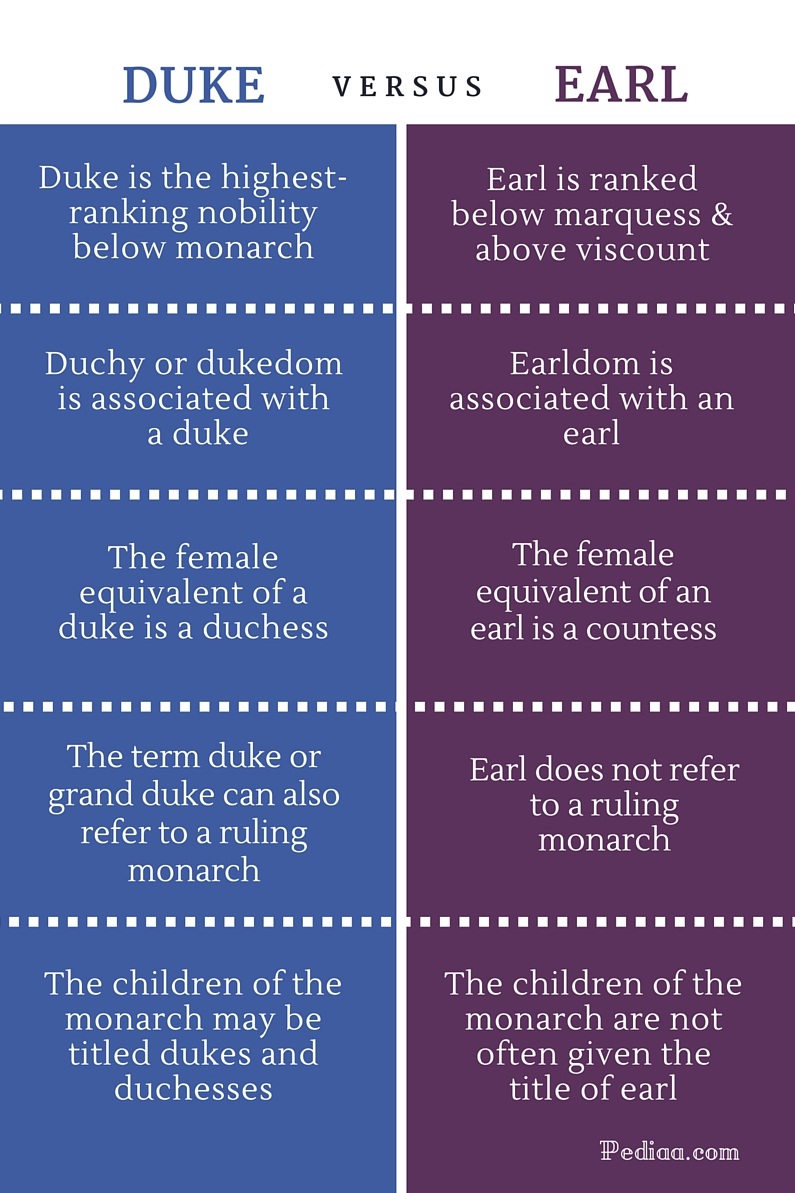Duke Vs Viscount Vs Earl: Understanding British Noble Titles
The hierarchy of British nobility can be quite complex, with various titles that have evolved over centuries. Understanding the distinctions between these titles, particularly Duke, Viscount, and Earl, is crucial for anyone interested in British history and aristocracy. In this article, we will delve into the characteristics, historical significance, and roles of these noble titles, providing a comprehensive overview that highlights their unique attributes.
Throughout history, the British peerage system has played a significant role in the governance and social structure of the United Kingdom. Noble titles not only signify rank but also come with specific privileges and responsibilities. By exploring the titles of Duke, Viscount, and Earl, we can gain insight into the intricate world of British nobility and its impact on society.
This article aims to clarify the differences and similarities between these three titles, offering valuable information for those seeking to understand the peerage system. Whether you are a history enthusiast, a student, or simply curious about British culture, you will find this exploration of Duke, Viscount, and Earl enlightening and informative.
Read also:Top Golf Little Rock Swing For The Best
Table of Contents
- 1. The Title of Duke
- 2. The Title of Viscount
- 3. The Title of Earl
- 4. Comparative Analysis of Duke, Viscount, and Earl
- 5. Historical Context of British Nobility
- 6. Modern Relevance of Noble Titles
- 7. Common Misconceptions About Noble Titles
- 8. Conclusion
1. The Title of Duke
The title of Duke is the highest rank in the British peerage system, just below the monarch. Dukes often hold vast estates and have significant influence over the regions they oversee.
Duties and Responsibilities of a Duke
Dukes have historically played crucial roles in governance, military leadership, and local administration. Their responsibilities may include:
- Advising the monarch on national issues.
- Representing their region in the House of Lords.
- Managing large estates and their economic affairs.
Notable Dukes in History
Some of the most notable dukes in British history include:
- Duke of Wellington – Famous for his victory over Napoleon at the Battle of Waterloo.
- Duke of Marlborough – Renowned military leader during the War of the Spanish Succession.
2. The Title of Viscount
The title of Viscount ranks below that of an Earl and above a Baron. It is derived from the Latin term ‘vicecomes’, which means ‘deputy count’.
Duties and Responsibilities of a Viscount
Viscounts often serve as deputies to Earls and may take on various roles, including:
- Overseeing specific local issues in the absence of the Earl.
- Participating in the House of Lords.
- Managing smaller estates compared to those of Dukes and Earls.
Notable Viscounts in History
Some of the prominent viscounts include:
Read also:Peoria Civic Center In Peoria Il Your Ultimate Guide
- Viscount Montgomery of Alamein – A celebrated World War II military leader.
- Viscount Asquith – Former Prime Minister of the United Kingdom.
3. The Title of Earl
The title of Earl is one of the oldest and most traditional titles in the British peerage system, equivalent to the Count in other European countries.
Duties and Responsibilities of an Earl
Earls have traditionally held significant power and responsibility, including:
- Overseeing large territories known as ‘earldoms’.
- Serving as a liaison between the monarchy and local communities.
- Participating in legislative duties in the House of Lords.
Notable Earls in History
Some renowned Earls include:
- Earl of Oxford – An important figure in the Elizabethan court.
- Earl of Leicester – A key supporter of Queen Elizabeth I.
4. Comparative Analysis of Duke, Viscount, and Earl
While Dukes, Viscounts, and Earls are all part of the British nobility, they differ significantly in terms of rank, responsibilities, and historical context:
- Rank: Duke > Earl > Viscount
- Historical Role: Dukes often governed large areas, while Earls managed specific regions, and Viscounts acted as deputies.
- Modern Relevance: Dukes retain more influence in society than Viscounts or Earls today.
5. Historical Context of British Nobility
The British peerage system has a rich history dating back to the Norman Conquest in 1066. The establishment of titles like Duke, Earl, and Viscount helped solidify the feudal system and maintain order in society.
The Evolution of Titles
Over the centuries, titles have evolved, and the responsibilities of nobility have shifted, particularly with the advent of democracy and changes in governance.
6. Modern Relevance of Noble Titles
Today, while the political power of these titles has diminished, they continue to hold cultural significance. Nobility often engages in charitable activities and serves as public figures.
The Role of Nobility in Contemporary Society
Modern-day Dukes, Earls, and Viscounts often take on roles in:
- Philanthropy and charitable organizations.
- Cultural preservation and heritage management.
- Public speaking and media appearances.
7. Common Misconceptions About Noble Titles
Many people have misconceptions about the roles and powers of Dukes, Viscounts, and Earls. Some common myths include:
- All Dukes are wealthy aristocrats – While many are, some titles may not come with significant wealth.
- Viscounts have no real power – Viscounts hold important positions, albeit often subordinate to Earls.
8. Conclusion
In conclusion, the titles of Duke, Viscount, and Earl represent a fascinating aspect of British history and culture. Understanding their differences and historical significance enriches our appreciation of the peerage system. We invite you to share your thoughts on this topic in the comments section below, and explore more articles on British history for a deeper understanding.
Thank you for reading, and we hope to see you back on our site for more engaging content!
Article Recommendations


